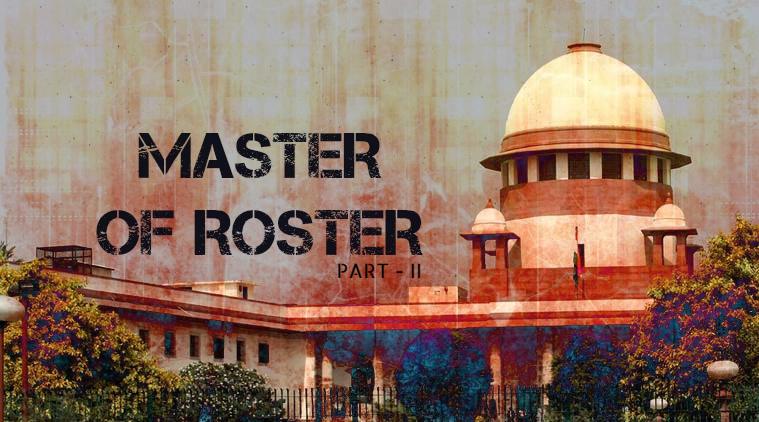In this series of ‘The Article Explains’, I shall today discuss about the major judicial pronouncements so far elucidating the correct position of the ‘Master of Roster’. In the previous piece, I discussed in detail about the term, its origin in Indian legal context and a comparative analysis of the term and it’s functioning with the USA, UK, and Japan.
There are many judgments of the High Courts declaring the Chief Justice of the High Court to be the ‘Master of Roster.’ The Supreme Court of India too has explained the correct position time and again. But, before the recent debate started on the extent of the power of Chief Justice of India as ‘Master of Roster’ the Supreme Court had got the opportunity to explain the position with respect to the Chief Justices of the High Courts only. However, the recent debate gave the Supreme Court a chance to explain the correct position with respect to the Chief Justice of India as well. Let us have a look at some of the major judicial pronouncements of some High Courts in this context before we move on to the Supreme Court’s decisions.
The High Court of Judicature at Allahabad had thrown light on this issue as early as 1959. The High Court while examining the scope of the power of the Chief Justice held as following in the matter of State v. Devi Dayal, AIR 1959 Allahabad 421 –
“It is clear to me, on a careful consideration of the constitutional position, that it is only the Chief Justice who has the right and the power to decide which Judge is to sit alone and which cases such Judge can decide.”
The Madras High Court in one of its en banc judgments in the matter of Mayavaram Financial Corporation Ltd. v. The Registrar of Chits. 1991 (2) L.W. 80, held that:
The Hon’ble the Chief Justice has the inherent power to allocate the judicial business of the High Court including who of the judges should sit alone and who should constitute the Bench of two or more Judges. No Judge or a Bench of Judges will assume jurisdiction unless the case is allotted to him or them under the orders of the Hon’ble the Chief Justice.
The Supreme Court in one of its decisions in the matter of State of Maharashtra vs., Narayan Shamrao Puranik, AIR 1982 SC 1198, almost reaffirmed the different concurring views of the various High Courts. The Supreme Court of India in this matter held that –
“The Chief Justice is the master of the roster. He has full power, authority and jurisdiction in the matter of allocation of business of the High Court which flows not only from the provisions contained in sub-s (3) of S.51 of the Act but inheres in him in the very nature of things.”
The Apex Court of India again made this position amply clear in the case of Matheshwari Prasad, (1996) 6 SCC 587, by holding that –
“It is the prerogative of the Chief Justice to constitute benches of his High Court and to allocate work to such benches, and judicial discipline requires that the puisne Judges of the High Court comply with directions given in this regard by their Chief Justice. In fact, it is their duty to do so. Individual puisne Judges cannot pick and choose the matters they will hear or decide.”
The Supreme Court in one of its leading judgments in this context in the matter of State of Rajasthan vs. Prakash Raj (1998) 1 SCC 1, has dealt with this issue extensively and in crux has held that the prerogative to constitute benches and allocate cases to the benches so constituted, lies only and only with the Chief Justice of the High Court, and therefore no puisne judge shall have any say in this matter.
The Supreme Court for the first time got the opportunity to examine the scope, nature, and extent of the power of the Chief Justice of India as the ‘Master of Roster’ in the recent matter of Campaign for Judicial Accountability and Reforms vs. Union of India (2018) 1 SCC. The Apex Court, in the crux, held that the judgment of the Supreme Court in the above-mentioned Prakash Raj case must apply to the Chief Justice of India as well. The Court in this matter laid down that principle applied in the Prakash Raj case must apply Proprio vigor as regards to the power of the Chief Justice of India.
Delivering judgment in the matter of Ashok Pande v. Supreme Court dated April 11, 2018, the top Court of the Country reiterated its previously interpreted position in this context. The Court held that:
In his capacity as a Judge, the Chief Justice is primus inter pares: the first among equals. In the discharge of his other functions, the Chief Justice of India occupies a position which is sui generis. From an institutional perspective, the Chief Justice is placed at the helm of the Supreme Court. In the allocation of cases and the constitution of benches, the Chief Justice has an exclusive prerogative. As a repository of constitutional trust, the Chief Justice is an institution in himself.
Most recently, the former Law Minister of India and a renowned lawyer Shanti Bhushan had approached the apex Court asking for the allocation of cases to be decided by the Collegium of five senior-most judges in place of the Chief Justice of India deciding it alone. He argued that the concentration of power in one hand is not in consonance with the spirit of democracy. But, the Supreme Court dismissed his petition relying extensively on the above-mentioned Ashok Pandey Judgment. The Court held that,
“In case the expression ‘Chief Justice’ is to be interpreted as ‘Collegium,’ it would be difficult to have a smooth day to day functioning of the Supreme Court.”
Therefore, the settled position so far is that the Chief Justice of India is the ‘Master of Roster’ and he has the exclusive authority to determine the benches and allocation of judicial matters.
Further, Read More:



